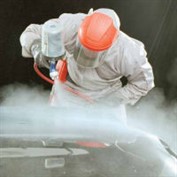Isocyanates in motor vehicle repair: Reducing exposure through training

The Challenge
HSE has identified that asthma is a major cause of ill-health in
the motor vehicle repair (MVR) industry. Two-pack paints are used
extensively in primers and lacquers. Isocyanates are also found in
a number of construction products including polyurethane paints,
coatings, foams, glues and flooring. They have a number of health
effects, such as:
- irritation of the eyes, nose and throat
- dermatitis
- occupational asthma - this is a significant risk for workers
spraying products containing isocyanates
Under the Control of Substances Hazardous to Health (COSHH)
Regulations employers must protect against the risks from
isocyanates through Assessment, Control and Review.
The Solution
To address the lack of awareness of the potential risks among
employers and sprayers, we worked with HSE inspectors and with
trade associations to develop simple and clear guidance. This was
delivered through a series of multi-media presentations at Safety
and Health Awareness Days (SHADs), 28 of which were held across the
country in a sustained campaign between 2004 and 2007.
At these events, a range of experts provided information at
these events about the hazards and risks associated with spraying
isocyanates and how to control exposure so as to prevent
ill-health:
- a video of an interview with an asthma sufferer brought home
the life-changing consequences of the condition.
- scale models developed by our ventilation specialists used a
smoke generator to show how ventilation systems in spray enclosures
work and how long it takes for paint mist to clear after
spraying.
- industry speakers gave presentations on paints and
equipment
- an HSE Inspector gave a clear message about the legal
requirements.
Scientists from our biological monitoring team also distributed
sampling kits, enabling sprayers to collect a urine sample after
spraying for analysis of isocyanate metabolites. This provided a
simple check on whether the exposure controls were working
properly.
The Outcome
The SHAD campaign was highly successful. Post-event
questionnaires showed improved awareness of the issues, with well
over 90% of attendees pledging to make improvements. Quantitative
data from urine samples showed that exposure levels were lower in
workers who had attended the SHAD events than those who had not.
Where urine levels of isocyanate metabolites were above the
Biological Monitoring Guidance Value, the individual was advised to
look again at control measures, make improvements and repeat the
test. These follow-up samples revealed lower levels of metabolites
and a reduction in exposure.
A further significant demonstration of the effectiveness of the
campaign came from subsequent HSE statistics: in 2004 to
2006, the incidence of occupational asthma in vehicle spray
painters, along with associated costs, was approximately
half that for the period 2001 to 2003.
For more information about how we could do something similar for
you, email us at: registration.sample@hse.gov.uk
Back to the top